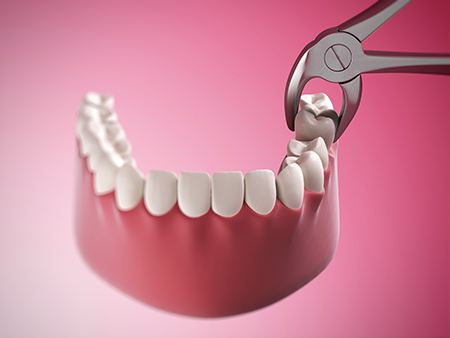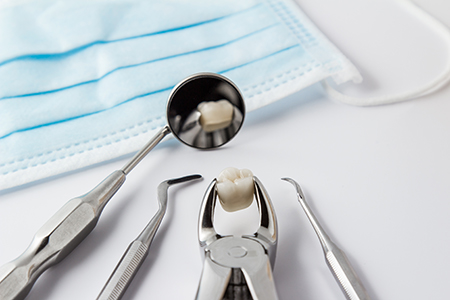General & Cosmetic Dentistry
The office of Keith A. Kye, DDS, FAGD serves the neighborhoods of Huntersville, Lake Norman, Davidson and Cornelius.


Preserving natural teeth is always our first priority, but there are circumstances when removing a tooth is the safest, most predictable path to protect your long-term oral health. Extractions can stop the spread of infection, relieve pain, prevent damage to adjacent teeth, and remove teeth that are no longer functional. When recommended, an extraction is part of a plan that considers your whole mouth and your overall well-being.
At the office of Keith A. Kye, DDS, FAGD, we approach each extraction as a carefully considered decision. Our team evaluates the tooth in context—looking at bite relationships, gum and bone support, the status of neighboring teeth, and any systemic health factors that affect healing. This lets us recommend the most appropriate timing and technique for your situation.
We know the idea of a tooth removal can be stressful. That’s why we focus on clear communication: explaining why an extraction is recommended, what alternatives were considered, and how the procedure fits into a comprehensive treatment plan. Our goal is to make the process as comfortable and predictable as possible for every patient.
An over-retained primary (baby) tooth or one that is badly decayed
Sometimes a primary tooth does not fall out on schedule because its roots fail to resorb or it becomes fused to the jaw. When a baby tooth prevents a permanent tooth from erupting properly, or when it is so damaged that it affects the developing bite, removal may be recommended to support normal growth.
A permanent tooth with extensive decay that cannot be restored
Decay can progress from the enamel into the deeper layers of a tooth, ultimately compromising structure and nerve health. When a tooth has lost too much healthy structure and restoration would not provide a reliable long-term result, extraction becomes the conservative option to protect adjacent teeth and surrounding tissues.
Severe fractures or cracks that render the tooth non-restorable
Teeth can fracture in many ways. If a crack extends below the gum line, involves the root, or otherwise leaves insufficient tooth to support a restoration, removal may be the most predictable way to prevent recurring pain or infection.
Advanced periodontal disease that has weakened supporting structures
When gum disease advances, the bone and soft tissues that anchor teeth can deteriorate. Teeth that have become loose or are causing recurrent infection may need to be extracted as part of an overall periodontal treatment plan to preserve the health of the remaining dentition.
Wisdom teeth that are impacted, poorly positioned, or decayed
Third molars often lack adequate room to erupt properly. When they become impacted, cause crowding, damage adjacent teeth, or develop decay that cannot be predictably restored, removal is frequently the best course to prevent complications.
Teeth removed to enable orthodontic treatment
In some orthodontic plans, removing select permanent teeth creates space to align the bite effectively. Extractions for orthodontic reasons are carefully coordinated with the orthodontist to achieve a balanced, functional, and attractive result.

Every extraction begins with a thorough review of your medical history and a detailed dental exam. We ask about medications, medical conditions, and prior surgical experiences so we can tailor your care and identify any precautions. In some cases, coordination with your physician or temporary medication adjustments may be advised to help you heal safely.
Imaging is a key part of planning. Digital radiographs give us precise information about the tooth roots, bone volume, and nearby anatomical structures, so we can select the least invasive approach. When necessary, additional imaging may be used to map complex root anatomy or impacted teeth before treatment.
We’ll also discuss anesthesia and comfort options up front. Local anesthesia is standard, and for patients with anxiety or more extensive surgical needs, we offer additional sedation options to keep you calm and comfortable throughout the procedure. Preoperative instructions are provided so you arrive ready and informed.
Before we begin, your individualized treatment plan will explain what to expect during the extraction, any temporary restorations or prosthetic considerations, and the timeline for follow-up care or replacement of the missing tooth when appropriate.
A simple extraction is performed when the tooth is fully visible in the mouth and the root shape is straightforward. After numbing the area thoroughly, the tooth is gently loosened and removed with specialized instruments. The procedure is typically quick and recovery is usually uncomplicated when post-operative directions are followed.
When a tooth is broken below the gumline, fused to bone, or impacted, a surgical extraction may be required. This procedure can involve a small incision in the gum and the careful removal of minimal bone to access the tooth. Complex cases may be referred to an oral and maxillofacial surgeon who specializes in advanced extractions.
For surgical extractions, we take extra steps to minimize discomfort and protect healing: precise anesthesia, considerate tissue handling, and clear postoperative directions. Sedation options and any needed medical clearances are discussed beforehand so patients can proceed with confidence.

Healing begins the moment the tooth is removed. Following the post-operative instructions closely reduces complications and speeds recovery. We provide written guidance tailored to your procedure, including activity restrictions, wound care, and expectations for swelling and discomfort during the first days after extraction.
Most patients manage pain effectively with over-the-counter medications, though prescription options are available when needed. If antibiotics are indicated because of infection or certain medical conditions, we’ll prescribe them and explain the schedule clearly so the medicine supports healing.
Monitoring your healing is important. Some cases require a brief follow-up visit to remove sutures or check that bone and soft tissue are closing appropriately. If you notice unexpected symptoms—such as increasing pain, prolonged bleeding, or signs of infection—contact our office so we can advise you on next steps.
Control bleeding with gentle pressure
Bite down on the gauze provided to maintain pressure over the extraction site. Change the gauze only as instructed, and expect light oozing for up to 24 hours. Persistent heavy bleeding should be reported to our office.
Protect numb tissues
Avoid chewing or touching lips, cheeks, or tongue until numbness from local anesthesia has completely resolved to prevent unintentional injury.
Take medications exactly as directed
Antibiotics:
If prescribed, take the full course to reduce the risk of infection.
Pain control:
Begin pain medication as recommended before the anesthetic wears off to stay ahead of discomfort. Use any prescribed medications responsibly and only as directed.
Avoid actions that dislodge the clot
Do not rinse vigorously, spit forcefully, use a straw, or smoke for the first several days. These actions can disturb the blood clot that forms in the socket and delay healing.
Manage swelling with ice
Apply an ice pack to the cheek intermittently during the first 24 hours to minimize swelling. Follow the schedule provided in your post-op instructions.
Avoid tobacco
Smoking interferes with healing and increases the chance of complications. Refrain from tobacco use for at least the first week after extraction.
Choose soft, gentle foods
Stick to soft or lukewarm foods for the first few days. Avoid hot, spicy, or carbonated beverages that can irritate the surgical site.
Keep the mouth clean but be gentle
Resume brushing other areas of the mouth carefully, avoiding direct contact with the extraction site for a few days. After 24–48 hours, a mild saltwater rinse can help keep the area clean; follow the exact timing and technique we recommend.
Attend follow-up appointments
If sutures were placed or a more complex procedure was performed, you will be scheduled for a follow-up visit to monitor healing. Keeping that appointment helps ensure a smooth recovery.
If you experience increasing pain, prolonged bleeding, swelling that worsens after 48–72 hours, or any unusual symptoms, please contact our office so we can provide appropriate guidance.

Removing a tooth is only one step in restoring a healthy, functional smile. In many cases we discuss replacement options at the time of extraction planning so that you have a clear path forward. Choices commonly include removable prosthetics, fixed bridges, and dental implants—each with its own advantages depending on the site, bone support, and your personal goals.
When appropriate, dental implants offer a long-term solution that closely mimics the look and function of a natural tooth. If an immediate replacement is important for function or appearance, we’ll review temporary options and the timing for definitive treatment so your comfort and confidence are prioritized throughout the process.
Our team coordinates care to make transitions seamless—whether that means preparing the site for an implant, designing a bridge, or fabricating a comfortable removable option. We’ll outline the sequence of care, expected healing milestones, and how each choice may affect long-term oral health.
Choosing the right path after an extraction is a personal decision. If you’d like a thoughtful, individualized discussion about replacement options, our team is ready to help you weigh the clinical factors and the outcomes that matter most to you.
Extractions are a common, carefully managed aspect of dental care when preserving a tooth is no longer in a patient’s best interest. With thorough evaluation, precise technique, and clear aftercare instructions, the process is predictable and focused on protecting your overall oral health. The office of Keith A. Kye, DDS, FAGD provides considerate, evidence-based care to guide you from the decision to extract through recovery and any needed restorative work.
If you have more questions about extractions or would like to discuss your specific situation, please contact us for more information.
The most common reasons for tooth loss include advanced periodontal disease, extensive tooth decay, and facial trauma. According to statistics, gum disease is responsible for close to 70% of tooth loss in adults. Although less frequent than the preceding three reasons, it should also be noted that specific diseases, drugs, smoking, and poor nutrition contribute to the risk of tooth loss.
The Centers for Disease Control and Prevention report that in the United States, an average of 12 teeth (including the wisdom teeth) are lost by the age of 50. Also, 26% of adults between 65 and 74 years of age have lost all their teeth.
Every patient and every situation is different. However, when a tooth and the surrounding tissues are numbed with a local anesthetic, you should only expect to feel a bit of pressure, but no pain as the tooth is being loosened from the surrounding tissues and extracted. For patients who are apprehensive and for some surgical extractions, our office will discuss our options in dental sedation to provide further relaxation and reduce any sense of discomfort.
While it's normal to feel some tenderness and swelling following an extraction, the degree of these sensations can vary. It mostly depends on the complexity of the extraction and the body's response to the procedure. We'll recommend or prescribe the appropriate pain medication to help ensure your comfort and give you specific instructions for maximum effectiveness and safety.
Typically, the recovery period following a simple extraction is shorter than a surgical extraction. However, a patient's overall health, habits, the size and location of the tooth, and other variables can influence recovery and healing. To speed up the recovery and avoid any complications, patients must follow the given at-home instructions diligently. We'll carefully review what to expect following your procedure and go over your post-op instructions.
Smoking interferes with blood clot formation, which is an essential first step in the healing process. Blood clot formation not only provides a protective layer to cover the underlying exposed bone and nerve endings, but it also supports the growth of new tissue. Cigarette smoke also contains chemical toxins that can disrupt the healing process and lead to problems such as continued inflammation, infection, or dry socket.
In a very small percentage of cases, a condition known as dry socket can develop in the aftermath of a dental extraction. This painful condition can arise when the blood clot in the extraction site doesn't form properly or gets dislodged. With dry socket, you may experience throbbing pain and symptoms such as bad breath and an unpleasant taste in your mouth. As skilled providers of care, our office will provide immediate treatment to alleviate your discomfort and promote healing.
The last teeth in your mouth to develop, wisdom teeth often do not have enough room to fully erupt or may be positioned in the wrong direction. These issues can affect your dental health as well as overall wellbeing. While some individuals never develop all their wisdom teeth, and a few have sufficient space for them, there are many people with partially or fully impacted third molars. Our office will monitor the development, position, and health of your wisdom teeth and will advise you if and when extractions are indicated.
After a tooth is removed, bone-grafting material is sometimes placed in the socket to promote healing and encourage new bone development. This procedure is often performed to support the eventual and successful placement of a dental implant.
At the office of Keith A. Kye, DDS, FAGD, we strive to make dental care affordable and accessible. Depending on the type or complexity of the extraction and other variables, the cost of the procedure can vary. Based on our diagnostic findings, our office will inform you of the healthiest choices in care, explain the fees, discuss insurance coverage, and explain your payment options.
Many dental plans offer some level of coverage for tooth extractions. We'll advise you if your plan covers the full cost of the procedure and if there is any out-of-pocket expense. Our business office will work with you to maximize your insurance benefits as much as possible while helping you minimize any out-of-pocket expenses.
Extractions are recommended when a tooth cannot be preserved without causing further harm to surrounding teeth or tissues. Common clinical reasons include extensive decay that leaves too little tooth structure for a predictable restoration, severe fractures that extend below the gum line, and advanced periodontal disease that has compromised the tooth's support. Impacted or problematic wisdom teeth and primary teeth that interfere with normal eruption also sometimes require removal.
The decision to extract follows a careful assessment of the whole mouth, not just the single tooth. We review X-rays, periodontal status, bite relationships, and any medical factors that affect healing to determine whether extraction is the safest path. When removal is advised, it is presented as part of a broader treatment plan that addresses immediate needs and future restoration options.
A simple extraction is appropriate when the tooth is fully visible in the mouth and the root anatomy is straightforward, allowing the dentist to loosen and remove it with common instruments. Surgical extraction is considered when a tooth is broken at the gum line, impacted, fused to bone, or presents complex root anatomy that cannot be accessed easily without making a small incision. Imaging, such as digital radiographs helps determine which approach will be least invasive and most predictable.
The patient's general health, level of anxiety, and the tooth's position are also part of the planning process. For more complex cases, coordination with an oral and maxillofacial surgeon may be recommended to ensure optimal outcomes. In every case, the chosen technique aims to minimize trauma and promote efficient healing.
Your visit begins with a review of medical history and a focused clinical examination to confirm the treatment plan and any necessary precautions. Local anesthesia is administered to numb the area thoroughly, and additional sedation options may be offered for comfort during longer or more involved procedures. The actual removal of the tooth is performed with careful technique, and time in the chair varies depending on whether the extraction is simple or surgical.
After the tooth is removed, the site is gently cleaned and, if needed, sutures are placed to support healing. You will receive specific post-operative instructions about bleeding control, activity limits, and oral hygiene to follow during the first days after the procedure. We make sure you understand what to expect and how to manage common symptoms before you leave the office.
Local anesthesia is the standard for most extractions and effectively numbs the tooth and surrounding tissues so you remain comfortable during the procedure. For patients with dental anxiety or for longer surgical procedures, additional options such as nitrous oxide (laughing gas) or oral sedatives may be offered to help you relax. In certain complex cases, deeper sedation or general anesthesia provided by a qualified anesthesiologist can be arranged through a surgical facility.
We review medical history and current medications to select the safest and most appropriate anesthesia strategy for each patient. If coordination with a physician is needed for medical clearance or medication adjustments, we will guide you through that process before treatment. Your comfort and safety are prioritized at every step.
Proper post-operative care helps reduce discomfort and lowers the risk of complications. Bite gently on gauze to control bleeding, avoid vigorous rinsing or spitting for the first 24 hours, and refrain from using a straw or smoking because these activities can dislodge the developing blood clot. Apply intermittent ice to the cheek for the first 24 hours to control swelling and follow the medication instructions provided to keep pain manageable.
Maintain oral hygiene by brushing other teeth carefully and, after 24–48 hours, begin gentle saltwater rinses as advised to keep the socket clean. Stick to soft, lukewarm foods for the first few days and avoid chewing directly on the surgical site until healing is well underway. Attend any scheduled follow-up visits so the clinician can check sutures and confirm appropriate tissue closure.
While most extractions heal without issue, certain complications can occur and require prompt attention. Common concerns include prolonged bleeding, signs of infection such as increasing pain or swelling after 48–72 hours, and a painful condition called dry socket that results when the blood clot is dislodged. If you notice heavy bleeding, worsening pain, fever, or other unusual symptoms, contact the office so we can evaluate and intervene if necessary.
Management depends on the problem identified and may include local treatment to protect the socket, a course of prescribed antibiotics for infection, or medicated dressings for dry socket to relieve pain and encourage healing. Preventive steps, such as following post-op instructions and avoiding tobacco, significantly reduce the likelihood of complications. Your dental team will explain when to seek immediate care and how we can support recovery.
Follow-up timing is determined by the complexity of the extraction and whether sutures were placed. For routine, uncomplicated extractions, a follow-up visit may not be necessary unless symptoms arise, but more involved surgical extractions typically require a short-term check to remove sutures and confirm proper healing. The dentist will tell you whether and when to return before you leave the office.
If you experience unexpected signs such as increasing pain, persistent bleeding beyond the first day, swelling that worsens after the initial 48–72 hours, or any systemic symptoms like fever, schedule an appointment promptly. Early evaluation allows timely treatment and helps prevent more serious problems from developing.
An extraction is often the first step in a longer restorative plan, and thoughtful timing can preserve options for replacement. Choices commonly include removable prosthetics, fixed bridges, and dental implants, each of which has specific site preparation and healing considerations. When an implant is planned, we assess bone volume and may recommend grafting at the time of extraction or later to create a suitable foundation.
Discussing replacement goals before the extraction allows us to plan the sequence of care to protect esthetics and function. The office of Keith A. Kye, DDS, FAGD coordinates restorative treatment so transitions are as seamless as possible and your long-term oral health is prioritized. We explain timelines and expected milestones so you can make informed decisions about the best restorative approach for your situation.
Third molars, or wisdom teeth, commonly become impacted because there is insufficient room for them to erupt properly, which can lead to pain, infection, or damage to adjacent teeth. Even when not currently symptomatic, problematic positioning, recurrent infections, or cyst formation are reasons clinicians may recommend removal to prevent future complications. Evaluation usually includes a clinical exam and radiographs to assess the angle of eruption and relationship to nearby structures.
Timing depends on the individual patient and the specific findings; earlier assessment during late adolescence or young adulthood often allows simpler removal with faster recovery. If imaging shows close proximity to important anatomical features or complex root formation, a referral to an oral surgeon may be considered for a comprehensive surgical plan. Regular monitoring by your dentist helps determine the most appropriate timing for intervention.
Children who require extraction of a primary tooth are managed with techniques tailored to their developmental needs and comfort. Indications include over-retained baby teeth that block permanent eruption, severe decay, or trauma that compromises the tooth's health. Pediatric extractions emphasize clear communication with the child and caregiver, behavior management strategies, and appropriate anesthesia or sedation options to ensure a positive experience.
We coordinate care with parents to explain aftercare, expected healing, and how extraction may affect the developing bite. When removal is done to allow proper eruption of permanent teeth or to support orthodontic goals, timing is planned carefully to support normal growth. If you have concerns about a child's tooth, a timely evaluation helps determine whether extraction or an alternative approach is best.

The office of Keith A. Kye, DDS, FAGD serves the neighborhoods of Huntersville, Lake Norman, Davidson and Cornelius.